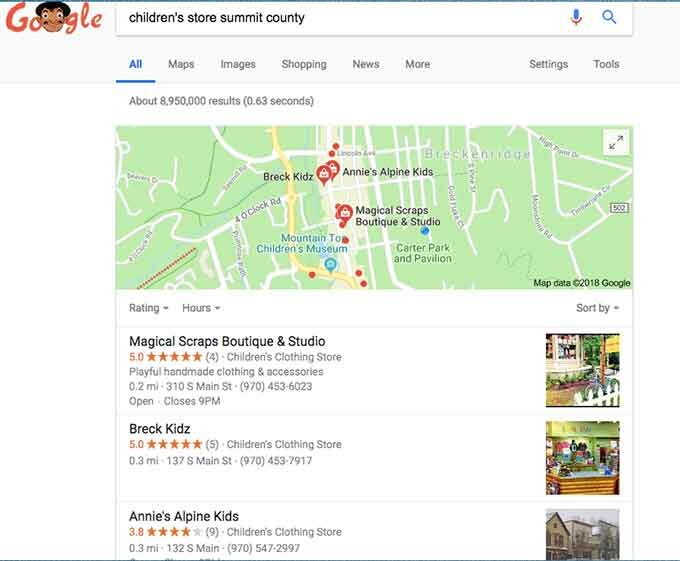You’ve heard the three letters but what do they really mean and how important are they to your business? SEO, or Search Engine Optimization, is the practice of increasing the quantity and quality of traffic to your website using techniques to ensure the search engines understand what your website is all about through organic (natural or non paid) search results.
If you own a business in a resort or mountain community, odds are you’ve relied on a good location, word of mouth, your personal network, and local reputation over the years to drive business. The digital age we live in today has turned up the heat of the competitive landscape as more and more potential customers turn to search engines and voice searches to find businesses they seek. Your competitors are stepping up their SEO efforts. And you should too if you want to stay competitive!
You have a website that you have invested time and energy to build, but now are you frustrated because your site doesn’t show up on the first or second page of Google search results? It might seem scary to attempt to navigate the SEO environment on your own, but don’t fret, we’ve broken down the basics to get you started.
Common issues businesses run into trying to rank higher in search results:
- Your website isn’t mobile friendly.
- You haven’t told Google your business exists.
- You aren’t publishing enough quality content, consistently.
- You are relying only on paid search results to drive business.
- You aren't expanding your reach with backlinks.
You might think, “I’m completely guilty of one or all of these" - or "I don't know what that means!" Don’t worry, you're not the only one. If you have a business in a resort or mountain town, it's common that you aren't skilled in optimizing websites. But our business is. Imagine That identifies website pain-points and works to get you first page Google search results. Read on for the five most common search issues small businesses face.
1. Your Website isn’t Mobile Friendly
If your website isn’t mobile friendly, we have tough news for you. In 2016, mobile internet usage surpassed desktop usage. It’s time to catch up! Traffic from mobile searches represent more than 60% of all searches globally. This statistic is exaggerated in mountain resort communities as most visitors are looking for information on local businesses from their mobile devices because they don't travel with their laptop or desk top computers, and certainly don't walk around with them.
A small investment in a responsive website design will help Google recognize your site as mobile friendly, quickly resulting in higher search rankings. This handy tool will let you know if your site is considered mobile friendly by Google. Imagine That has an extensive portfolio of responsive, mobile friendly, websites.
2. You haven’t Told Google Your Business Exists
There are many free “starter kit” SEO tools at the tips of your fingers. It is essential for local businesses to list their business with Google My Business. This is a crucial step for ranking high in Google search results. If you don’t provide Google with accurate business information, the right information (or any information) will not be delivered to your potential customers.
Not sure where to start, or having issues claiming your business listing? We’ll guide you through the process to take control of it. As Certified Google Partners we understand their process and regularly help clients claim and manage their Google My Business pages.
Google delivers a “three-pack” display in the SERP (Search Engine Results Page). This means that when a person Googles, “type of business” in Summit County, Google will now display the first three results in a boxed-in area at the top of the search results page. Users can click on the "more places" button, but the top three results most often catch users attention first!
Take a look at the below example of when we Googled “Children’s Store Summit County.” Telling Google about your business is the first step, but search engine optimization doesn’t end with simply filling out Google My Business. Talk to us about the ins-and-outs to supercharge your presence within Google's various types of search results.

3. You aren’t Consistently Publishing Enough Quality Content
A blog post (article or news story) here and there won’t boost your rankings if you don’t support them using best practices like keyword research, page architecture, content length, and engaging information in posts such as videos, vlogs (video blogs), and great photos.
By regularly publishing relevant, well researched, content on your blog, you provide Google substance for it's automated crawlers to index. This gives you the opportunity to establish what is known as "domain authority" in your market. Doing so on a regular basis sends the signal that your business is actively engaged in developing a leadership position and staying on top of industry trends. As your businesses "domain authority" grows, it will be ranked higher in search results and able to capture more high quality traffic.
4. You Rely on Paid Search Results to Drive Business
Statistics show that internet users find organic (non paid) search results more trustworthy when it comes to local searches. Over 70% of users click on links from organic search results. So why are you spending (or thinking about spending) so much money on paid advertisements? Listen to the data, it doesn’t lie. Organic traffic results from conquering the three issues covered above.
Some businesses decide to invest in both paid and organic search efforts, which can be a great strategy. Over time, paid search (pay-per-click campaigns) can be reduced in favor of improving search placement organically. Imagine that specializes in maximizing your investment and getting quality traffic to your business website and ultimately to your business.
Local SEO is Always Changing
Google is constantly updating its core algorithms and console environment. One of the more recent shifts to the search engine landscape is the HTTP to HTTPS transition. As of July 2018, users on Google Chrome using the Google search engine, will get a warning message about the potential security risk of websites that don't have a current secure socket layer or SSL certificate. If your website doesn't have an SSL certificate in place, you are likely losing potential customers. Even worse, an unsecured website leaves you vulnerable to malicious attacks, and software vulnerabilities that can put your business and your customers at risk.
These threats don’t need to be scary. We can help you decide what type of security certificate to install based on the functionality and purpose of your website which will signify to Google that your site is a “good apple.”
5. Off-site SEO
There are many components to a successful SEO strategy. In addition to the strategies outlined above, there are a number of activities that will lead to higher ranking in Google's search results. A strong "off-site" strategy builds your credibility and visibility in order to become more competitive and drive more business your way.
One of the more common issues faced by local businesses is having inconsistent or incorrect information on business listings around the web. There are thousands of directory sites that populate their databases with information scraped from the internet using robot crawlers. When your business has changes of name, address/location, phone number, or website domain, it is easy for this information to be erroneous on hundreds of directories. Even if the information is only slightly off, it makes a massive difference in the automated system's ability to match each listing with your business, therefor reducing your business's domain authority. SEO is boosted dramatically when these citations are cleaned up with accurate and consistent data. Additionally, it is good practice to continually add your business to online directories to increase your digital footprint and number of links that point back to your site.
This leads us to outline one of the most powerful SEO tactics --backlink building. Hundreds of links pointing to your site from high domain authority websites increases your visibility and the quality of traffic to your site. We use the analogy of "SEO juice" flowing through websites to each other, which produces gains in search result rankings and creates a web of online mentions and links that builds your website's credibility.
This strategy involves adding links by request or by producing guest blog posts that add quality content to complimentary but non-competing websites, and thus creates strong networks of interlinking websites and content. By participating in the flow of "SEO juice", websites establish an authoritative voice with an extensive reach to build higher rankings and quality traffic to build business growth.
“The best place to hide a dead body is on page two of Google.” -Unknown
Your business doesn’t need to continue suffering from page two blues. We are here to help. Imagine That is your local expert helping mountain resort businesses leverage the power of SEO to grow their revenue by capturing valuable search traffic from first-page Google search results. Contact us today for a free consultation on how we can help your business thrive.
